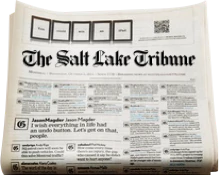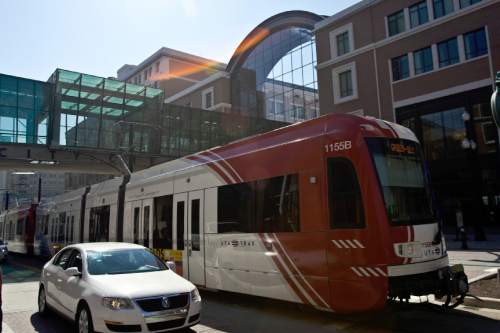This is an archived article that was published on sltrib.com in 2015, and information in the article may be outdated. It is provided only for personal research purposes and may not be reprinted.
The Utah Transit Authority Board adopted a 2016 budget on Wednesday that officials say will expand overall service by 5 percent.
It also avoids increasing fares and continues promotional discounts through the coming year for passengers who use electronic FAREPAY cards. Those offers reduce fares by 40 percent for bus-only riders and by 20 percent for others.
But the budget calls for the agency to dip into its cash reserves next year by $10.4 million to help it pay for such operations — although officials say such action eventually may not be needed.
Similarly, UTA had also budgeted to dip into reserves by $9.9 million this year, but did not actually do that, said Bob Biles, UTA vice president of finances.
The agency avoided that because it will receive $4 million to $5 million more from sales taxes than anticipated, he said, and operations this year cost $15 million less than budgeted — largely because diesel prices were far less than originally anticipated.
If similar low fuel prices and higher-than-anticipated sales-tax revenue occur again next year, UTA again may not need to dip into reserves.
"But we have it in the budget," Biles said, "in case we need it."
Legislative auditors have previously raised red flags about the UTA budget practice of going into reserves. Last year, they criticized the agency for spending more than revenues generate and said the practice contributed to shaky finances after UTA borrowed heavily to build new TRAX, FrontRunner and streetcar lines.
UTA, however, says using reserves is part of a long-term strategy to keep services constant for a few years while its debt payments are high on those recently completed rail lines. The agency also says it is on firm financial footing.
About 2.9 percent of the budget for operations comes from using cash reserves.
The budget calls for spending $359.9 million on operations next year, up 3.7 percent.
Sales taxes will provide 65.5 percent of revenues, fares will provide 14.2 percent, and another 17.4 percent will come from federal grants, advertising and other revenues.
Some of the spending in the budget includes:
Debt service, mostly on recent rail expansion • $103.6 million. That is 28.8 percent of UTA's total operating budget
Bus operations • $86.3 million, up 4.3 percent
Light rail (TRAX and the Sugar House streetcar) • $43.7 million, up 3.6 percent
FrontRunner commuter rail • $31.1 million, down 1.3 percent; however, some commuter-rail operations were transferred into other administrative accounts, and overall apples-to-apples funding is up slightly compared to last year
General and administrative costs • $38.8 million, up 4.2 percent
Top UTA executives and regional managers wrote to the board two months ago offering to give up controversial bonuses next year — so the budget contains no money for them.
Their offer came before voters voted on Proposition 1 to raise sales taxes for transportation — which passed in Weber, Davis and Tooele counties, but fell in Salt Lake, Utah and Box Elder counties within the UTA district.
Collection of extra money from Prop 1 in the three counties that passed it will not begin until April, and money will not be received by UTA until about August. The budget, for now, did not include such Prop 1 money. But UTA officials said they are planning how to use it in those counties as it becomes available.
The board also passed a capital-projects budget for next year totaling $175.7 million. The bulk of that — $106 million — is for ongoing construction of a "bus rapid transit" route between Orem and Provo.
Buses on that route will have their own traffic lanes in some stretches. Passengers must buy tickets from machines before boarding, and buses have more doors.
The capital-projects budget also includes money for five new ski buses, 33 paratransit vans, 115 rideshare vans and replacement Wi-Fi equipment for FrontRunner trains.



